| |
| |
 |
|
| |
|
|
| |
“The Great Wall of China! Of course, when I travel to China I am going to see that unparalleled creation of man. It’s one of my utmost dreams!” I remarked to a Canadian friend who advised me to place the Great Wall at the top of my travel itinerary. He smiled, “I am sure that you will never forget your trip to the Great Wall. I will always remember the first time that I climbed that Chinese landmark.”
His words came to mind when on July 7, 2007 approximately 100 million people around the globe cast their ballots by telephone and Internet, to declare that ‘The Great Wall of China’ was to be one of the ‘New Seven Wonders of the World.’ However, when the announcement came, I was not too surprised. This massive structure that has been a symbol of China for more than 2000 years is the country’s prime symbol and historic landmark.
Our goal the third day after we reached Beijing was the Badaling section of the Wall — to tourists, the most famous part due to its proximity to China’s capital. As we approached I was elated. A life-long ambition was soon to be fulfilled.
Turning and twisting, the Great Wall averages in most places 8 m (26 ft) high and 6m (20 ft) wide and was once crowned with some 25,000 towers. Like a giant snake, it winds its way for 6,000 km (3,750 mi) from east to west through five provinces, running along high mountain ridges, valleys, deserts and grasslands and was built as a defense barrier to ward off tribal nomads from the north. |
|
| |
|
|
|
|
| |
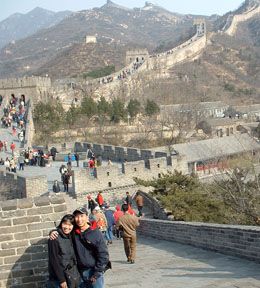 |
|
 |
|
| |
Tourists posing on the Great Wall |
|
Tourists on the Great Wall |
|
| |
The Wall began to be erected sometime between the 7th and 8th centuries B.C. when defensive ramparts were built in some northern areas in the country. In the 3rd century B.C. the first Emperor of China, Qin Shi Hauang, joined the ramparts together to create the first Great Wall of China. In the ensuing centuries, it was continually renovated and expanded, each dynasty adding to its length, height and width. However, the Wall took on its present form when the Ming Dynasty (1368 - 1644 A.D.) was in power.
During their era, a sophisticated defense system consisting of beacons and watchtowers, blockhouses and garrison towns were added. Cannons were placed in strategic areas and a signaling system that existed before was improved. The Wall, built of brick, masonry, rock and packed earth, became the nuclear deterrent of that age — ensuring that the Mongol incursions of the past were virtually made impossible.
The largest engineering and construction project ever carried out by man, the Wall is an awesome achievement — mind boggling to engineers even in our times. It is the only landmark on earth that is visible from outer space, but not from the moon as some would have us believe. It has been declared by UNESCO ‘One of the World’s Cultures Heritages’ and hence, has become a cultural legacy for all the nations of the world.
However, despite its cultural significance, only parts of the Wall remain. In places, sections of the Walls have disappeared through neglect or they have been razed, roadways have been cut through the Wall, and other parts became the source of building materials for peasant farmers. Yet, the Wall continues to draw millions of tourists who come to marvel at this stunning witness to Chinese history. |
|
| |
|
|
|
|
| |
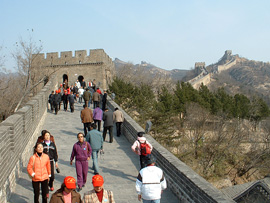 |
|
 |
|
| |
Tourists on the Great Wall |
|
The Great Wall at Badaling |
|
| |
|
|
| |
Tumbling out of our bus some 70 km (44 mi) from Beijing, at first glance I was thrilled as I surveyed the Badaling section of the Great Wall, built in the 16th century, towering before us. In recent years, this part of the Great Wall has been repaired and the Great Wall Museum, Badaling Cable-way and other tourist facilities have been built near the Wall. After these renovations, more than 80 million visitors, including 300 heads of state and other celebrities, have visited the Wall.
Soon I was standing atop this historical creation of man. On both sides of me, the Wall snaked up and down mountainsides far into the distance. Walking along I came to amazingly steep angles of the Wall steps, uneven in size and some seemingly made for giants.
Struggling up to highest section near the Badaling Gate, I huffed and puffed, each step becoming harder and harder to climb. I was seriously thinking of turning back when I noticed a woman of perhaps 25 years climbing by my side. Seeing me painfully making my way up, she smiled as she passed me. “You’ll make it! It’s not too far up!” I looked at her. “I doubt that I can make it!” It was an effort for me to even grin. “Come on! No pain no gain!” she advised, as she quickly made her way upward. I stopped, resting awhile thinking, “It’s easy for her! Wait till she’s over 80 like myself.”
Reaching the top, I rested and soon I felt better. “They must have been super soldiers those who manned the Wall in the bygone ages,” I reflected. I could not believe that every day, they would run up and down the steep steps.
As I surveyed the scene I felt that my painful climb had been worthwhile. From my vantage point, I got a good feel as to what climbing the Wall was all about. It was a clear autumn day and I was able to admire a breathtaking view of the golden landscape, a perfect scene for an artist’s brush. I felt contentment as the cool breezes soothed me while I relished the picture postcard view.
“Now, it will be easy the way down,” I thought to myself. How wrong I was! The path downward, less of an effort than climbing, was challenging. At certain points, it seemed to me the steps fell straight down. At other times, I almost stumbled due to the uneven distance of the steps, but steadying myself on the side rail, I made my way to the bottom.
However, in a short while, my struggles and pains were soon forgotten and the Wall again became a place of fantasy. Back on the ground, after the two hours that I had spent atop China’s most well known historic site, I remembered Chairman Mao’s words, “You will not be a great man if you do not climb the Great Wall.”
“Was I a great man now?” I smiled to myself. In any case, I had fulfilled a dream. |
|
| |
|
|
| |
|
|
| |
Tourist and author on the Great Wall of China |
|
| |
|
|
| |
On our way back to Beijing, when discussing the Wall and Chinese history, our guide summed it all up as he philosophized, “The Wall was built to keep out the Barbarians from the north, but today its function has changed. It is drawing visitors from the four corners of the globe to gaze on the handiwork of our forefathers. Imagine, our ancestors are still helping us — this time drawing in the dollars.” |
|
| |
|
|
| |
IF YOU GO |
|
| |
Facts About Beijing and China: |
|
| |
|
|
| |
1) Foreigners travelling to China must apply to a local Chinese embassy or consulate for tourist visas.
2) The currency of China, the RMB or Yuan, is currently valued at about 6.84 to the U.S. dollar and 6.4 to the Canadian dollar. Conversion of foreign currency can be done in banks or hotels. China is one of the few countries in the world where hotels give the same rates as the banks. The exchange rate for traveller cheques is more favorable than that for cash. Also, most credit cards are accepted.
3) Taxi fares in China are always clearly marked on the taxi window. Most taxi drivers do not understand much English. Hence, visitors should have their destinations written down by a hotel clerk in Chinese and show the written destination to the cab driver.
4) Only some tap water in China is potable. However, bottled mineral water is on sale everywhere.
5) A 90 Yuan airport departure tax is collected from passengers departing from any international airport in China — domestic flights 50 Yuan. |
|
| |
|
|
| |
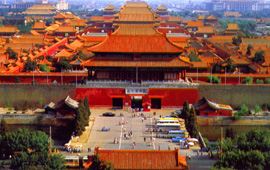 |
|
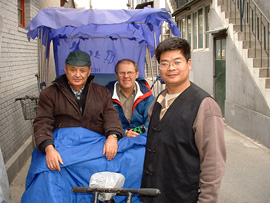 |
|
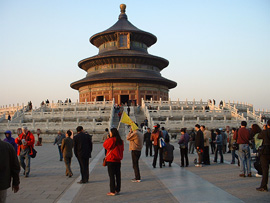 |
|
| |
Beijing - The Forbidden City |
|
Rickshaw ride in the Hutong District |
|
Beijing - The Temple of Heaven |
|
| |
|
|
|
|
|
|
| |
Historic Sites in Beijing: |
|
| |
|
|
| |
The Forbidden City - a symbol of Chinese history.
Summer Palace - one of the most famous royal gardens in the world.
Yonghe Lamasery Temple - the most famous lamasery in China.
Temple of Heaven - its ‘Hall of Prayer for Good Harvests’, considered to be the epitome of sacred Chinese architecture.
The Ming Tombs - some 50 km (31 mi) north of Beijing where 13 of the 16 Ming Emperors are buried. After walking through a lyrical willow-lined avenue called the Sacred Way, lined with stone statues of animals and court officials, one enters the tomb of the Emperor ZhuYijun and his two wives — the only tomb excavated.
Museum of Chinese History - located on the edge of Tiananmen Square.
White Cloud Taoist Temple - the largest Taoist temple in Beijing.
Sleeping Buddha Temple - noted for its 5 m (16 ft) statue of Sakyamuni - the Buddha.
Tanzhe Temple - noted for its pagoda gardens.
Fragrant Hills - once an imperial garden for the emperors |
|
| |
|
|
|
|
| |
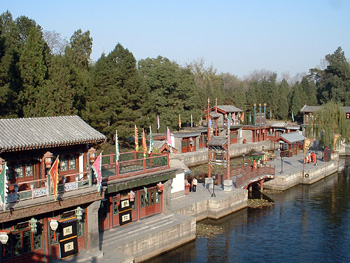 |
|
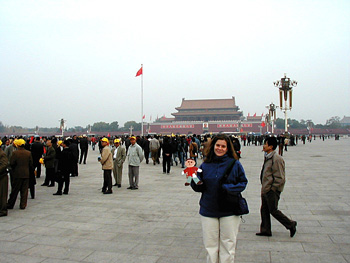 |
|
| |
Beijing - The Summer Palace |
|
Beijing - Tiananmen Square |
|
| |
|
|
| |
Habeeb Salloum can be reached by e-mail at: habeeb.salloum@sympatico.ca |
|
|
|

